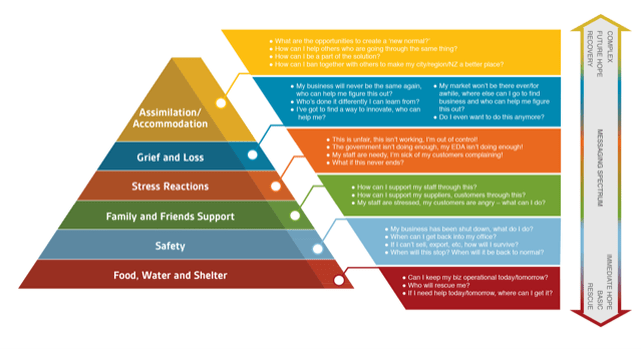COVID-19: business communication during disaster
The COVID-19 pandemic has hit many businesses hard. And, in fact, economists are now predicting we will enter a recession that could be worse than the global financial crisis we experienced in the mid-2000s.
Operating a business under these circumstances creates enormous stress for some. In fact many business owners have lost their companies entirely. If we think about what’s happened to the world’s airlines, most tourism businesses, retail and hospitality, this ‘crisis’ is incredibly devastating. In fact, it’s not an exaggeration to say it has reached ‘disaster’ proportions for many.
If we accept that a proportion of our business community is operating from a disaster mindset, how do we begin to assess where our clients, staff, stakeholders are at on the spectrum of ‘needing rescued’ to ‘fully recovered?’ And then once we know where they are at, how does that impact the way our organisation communicates with them?
Disaster Survivor’s Hierarchy of Needs
One way to gauge how your business audience is faring is to discover where they are at on the Disaster Survivor’s Hierarchy of Needs. This is a theory developed by Dr Karin Jordon at the University of Akron in the USA and is something communications professionals who have led teams through natural and other disasters would likely be familiar with. It’s aligned to what most of us have probably seen before – Maslow’s Hierarchy of Needs.
The basic gist of the Disaster Survivor’s Hierarchy of Needs is that when a disaster strikes, people are going to be thinking about their basic needs first – “where will I sleep tonight, how do I get clean water and food?”
Once those basic needs are satisfied, disaster victims will begin to think about their own safety and wellbeing and secondly of others. As time goes on, stress will manifest itself in a range of reactions from anxiety to anger and eventually grief and loss for what has been left behind.
And finally, disaster survivors find a new way of being and assimilate into a new pattern of normal life.
Business disaster survivors and communications planning
So, when we are thinking about the COVID-19 crisis and economic recession, we can look to this Disaster Survivor’s Hierarchy of Needs to understand what stages of recovery business owners/managers, our staff, our customers and suppliers and our business community colleagues are going through.
You need to understand where people sit in this hierarchy so that when you are communicating with them, you do so in a way that makes sense for them today. And the tricky part is that every business will be in a slightly different phase.
If you find your clients, for instance, are in a market that’s been heavily effected by COVID-19, you need to offer support, advice and products that can help them today. Messages must be focused on basic needs, about providing ‘rescue’ and all about giving hope for today and tomorrow.
On the other end of the spectrum, say you have clients in the IT sector who are run off their feet with new business - they may already be in the assimilation/accommodation phase. This means your communication with them can be more future-focused, complex and visionary.
The risks of making a communications mistake of mis-matching messaging that doesn’t sync with your audience’s stage in the disaster journey include: frustrating or even angering them, being perceived as irrelevant and being seen to be out of touch with the reality of the situation.
Alternately, the benefits of getting your communications right during a disaster can create huge opportunities for long-term brand loyalty, increased trust and solidifying your reputation as an industry leader.
Staff are disaster survivors too
This theory and the considerations you must be mindful of also relate to how you communicate with staff during this time. Even if your company is not making people redundant, you need to remember that people are dealing with a range of change all at once and that creates anxiety for many people.
You may have staff who love working at home, have no children at home and no other distractions and they are just getting on with work and doing well. For these staff, you can communicate with them as you normally do without much change.
However on the other hand, you may have staff who have small children at home, a spouse that’s been laid off and a range of other personal change that is causing huge stress.
These two staff members are going to be at opposite ends of the disaster survivor’s hierarchy of needs. These examples show that when you are communicating with your teams – one size does not fit all, so be sensitive to tailoring messages, work hours and expectations. The end result will be more engaged and loyal staff when the disaster is well and truly over.
